Homeless Fowl Looking for Love
PLEASE SHARE!
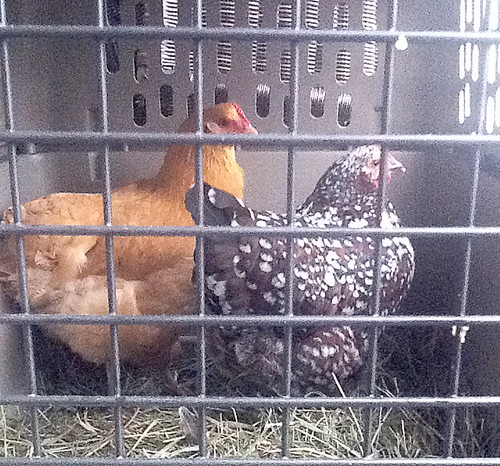
These two young hens were abandoned in Sammamish, WA and need a safe, happy forever home that will keep them as pets.
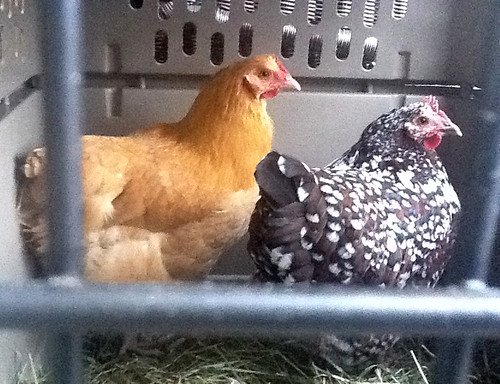
They like to forage for bugs and are good friends with each other. Do you have room for these two lovely ladies? Contact Lora at lorav1@comcast.net if you’re near Sammamish, WA and can provide a safe forever home.
Separately, this little guy is also looking for a safe, forever home.

His name is Mr Rhett Butler. He is a fine upstanding rooster citizen and would happily protect a flock of lovely hens. He would even be an only child if you have a safe forever home.
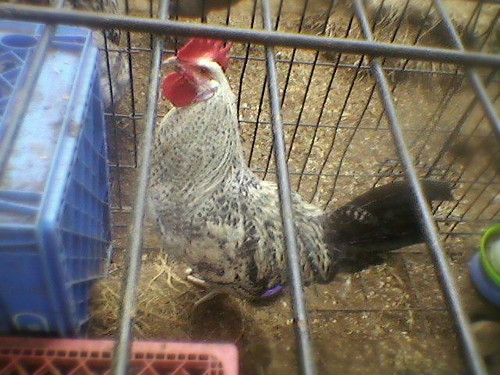
He’s not too picky, but he would like to be safe and happy. That’s not too much to ask now, is it? If you can help Rhett out, and you’re near West Seattle, WA, contact Anna at amh1786@gmail.com.
Thanks and quacks and clucks,
Tiff and the flock
Otter’s Vegan Korma Curry
And now for something completely different!

You may know that with all the rescued animals here, I’m vegan. That means for 4+ years now I’ve avoided all animal products as much as possible. (I was also vegetarian for several years before going vegan). But before all that, I used to looove korma. True korma is a sweet/spicy, yogurt-based Indian yellow curry. My favorite korma was from a restaurant in San Francisco called India Clay Oven. I rarely met a korma I didn’t like, but their recipe was my favorite. After missing korma for over a decade, I recently decided to find a good non-vegan korma recipe and try to vegan-ize it.
With 4 versions tried and eaten over the past month, I’m finally confident that this recipe is super tasty. It’s a little simpler than the recipe I started from, so I call it “Otter’s Vegan Korma Curry.” I tried versions with Beyond Meat and Gardein, but in the end, I prefer this combo of mushrooms, cauliflower and tofu. If you try this vegan recipe yourself, please comment and let me know what you think!
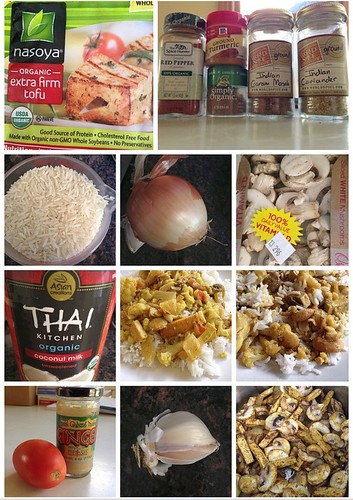
Ingredients:
4 Tbsp olive oil
1 small onion, diced
3 cloves of a garlic bulb, minced
1 tsp ground ginger
1 1/2 tsp turmeric
1 tsp cayenne/red pepper (for medium; 1/2 tsp for mild, 2 tsp for hot)
2 tsp Indian garam masala
2 tsp Indian ground coriander
1 tsp cumin
1 1/2 tsp salt
1 pint sliced fresh crimini mushrooms
6 oz super firm tofu
1 chopped tomato
1/2 head of cauliflower
1 15oz (regular size) can coconut milk
1/2 cup cashew nuts or almond slivers
2 cups basmati white rice
_________________________________
Directions:
Break the cauliflower into small florets and steam or boil until softened but not soggy (12 minutes steamed).
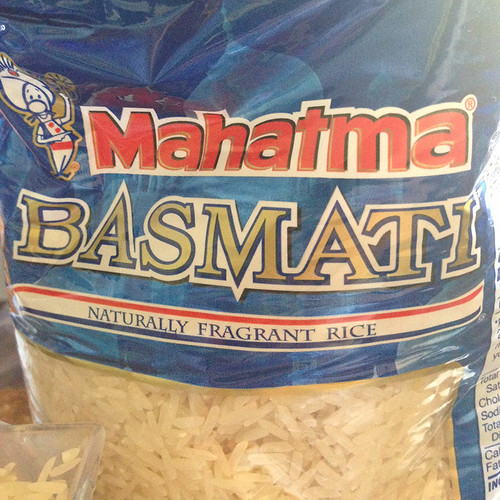
Start the rice. Use basmati rice, preferably from Pakistan. It makes a big difference. Follow directions on package using about 2 cups of rice. It likely takes about 20 minutes.

Using a high-sided pan over medium heat, add the onion and garlic to your olive oil and cook for 1 minute.
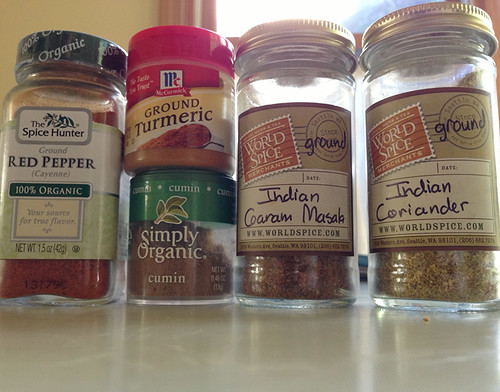
Add the spices: turmeric, cayenne, garam masala, cumin, salt, and coriander. Stir for 1 minute.

Add the chopped tomato and ginger, and then the tofu and mushrooms. NOTE: Adjust heat or add a bit more oil to ensure your spices aren’t burning.
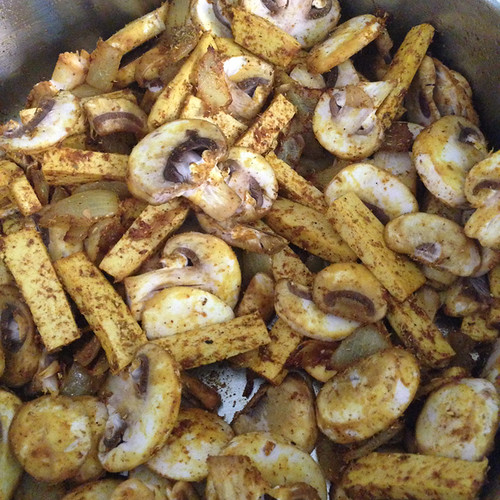
Cook until the mushrooms and tofu soak up the spices (2-4 minutes). Add in your steamed cauliflower and cook another 1-2 minutes.

Stir in the entire can of unsweetened coconut milk. Let it all simmer for 5-10 minutes.
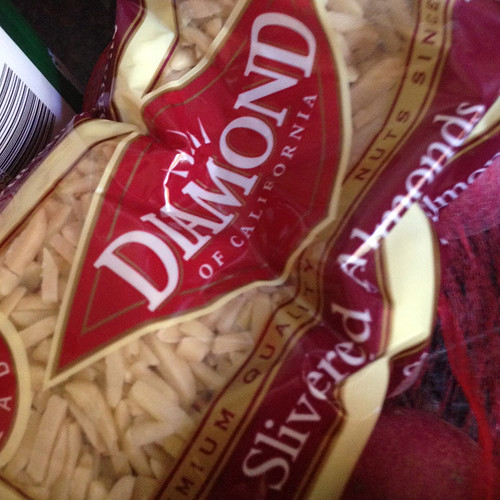
Right before serving, add the cashews or almond slivers. NOTE: Without the cayenne, you’ll need more salt. This recipe is a bit undersalted because of the variance in cayenne… adjust to your own taste.

Garnish with a bit of cilantro and serve over basmati rice.
Bon appetit!

Makes 6-8 servings. Re-heats well in the microwave and is great for freezing.
Cooking time: 25 minutes.
I am a Wizard!
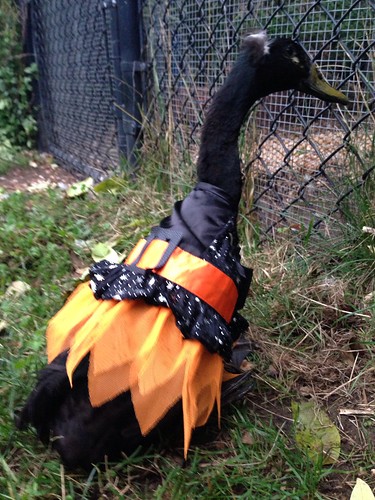
“What’s that, Danny girl? Lionel is being dorky!? I will save you!”

“Now how do I cast a spell again? Oh that’s right… Ducks and clucks and muddy muck. Make Lionel behave like a GOOD duck.“

“Did it work? Is he still being dorky?”

“I’m pretty good at this.”
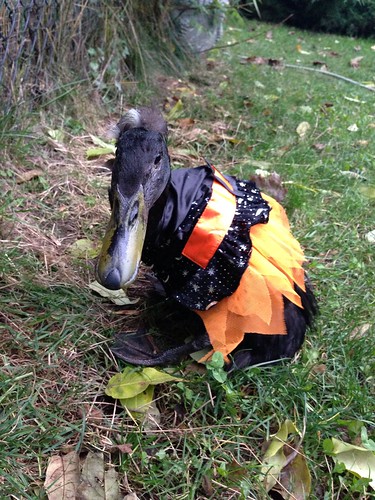
“Okay, I’m done being a Wizard. Take this off.”
You got it, Lessie. Thanks for playing along and dressing up. You make a GREAT wizard!
Lester dressed up very briefly so we could share a photo with his veterinarian. They’re running a contest and the prize is a free nail trim. Since Lessie is handicapped, he doesn’t walk enough to wear down his nails. So that would be a GREAT prize for him!
HaPpY HaLLoWeEn everyone!
Foster kid Francis’ Cause of Death
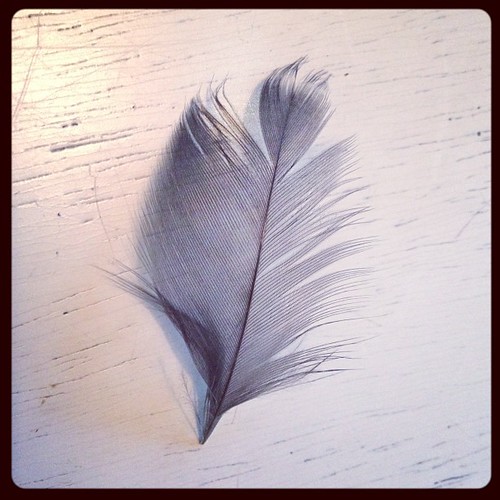
If you haven’t already heard, our foster duckling Francis passed away unexpectedly on Saturday afternoon. Francis started limping on Thursday, went to the vet Friday and died Saturday. We all thought he had a sprained leg, but when he died suddenly, we had his remains necropsied by the vet to determine why he passed.
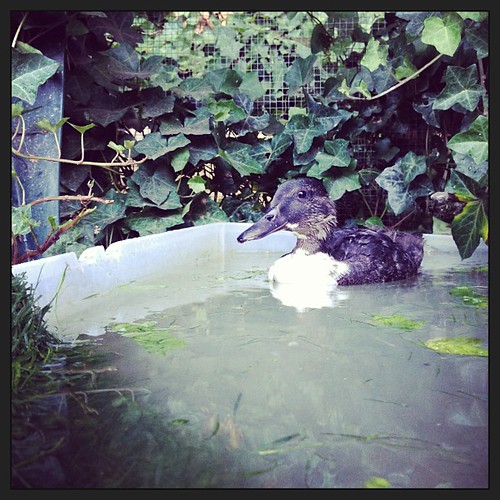
Francis’ necropsy showed severe kidney and liver disease. The vet said “it didn’t have anything to do with you in any way” which was a relief for us to hear. Unfortunately, Francis never had a chance. The liver damage was so severe that he bled internally, even into his muscles. If he were older, it could be a common problem in ducks called amyloidosis, which is sort of an immune-related disease. However, since Francis was so young (likely only 5 to 6-weeks-old) we’re having tissue samples sent out to a special lab to determine if the liver and kidney damage was caused by a virus or bacteria.

The good news is that it wasn’t caused by another duck picking on him here with us and he didn’t have a sprained leg. He was safe here like we thought he was, and he wasn’t hurt by the other ducks. It’s also good for me, as I don’t have to feel guilty that I should have done more to keep him safe. He was safe. I feel much better about that.

It’s also good that Francis was a feisty, active kid up until Thursday afternoon, and he died two days later. So he was pretty happy and rambunctious right up until his last two days.
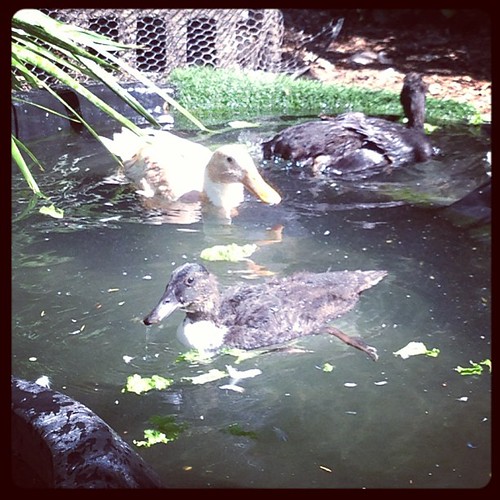
The bad news is just that Francis is gone, and there’s nothing that could have been done to save him. We will share the results of the tissue sample analysis when we get that back, but it will likely be quite a while – two weeks or more. It might shed some light on why he was afflicted with kidney and liver disease so young. Hybrid ducks are known to have many problems, so it’s possible it was congenital or genetic. We’ll share when we know more.

I know his death came as a shock to many of the people who followed his short journey with us. It was especially hard for me, because I thought I might have let him down. When his limp was worse Friday morning and I made an appointment for the vet, Francis did something that a few other animals have done with me in the past. He directly asked me for help. I can’t explain it because it’s subtle, but Ramona did it in the past when she had aggressive lymphoma. Ramona, who was normally skittish and mostly ignored me, walked right up to me and stood in front of me asking for help. In her case, I was able to listen and the vet was able to do surgery and treat her with steroids which gave her a few extra months of great life before she succumbed to the lymphoma.
Francis did the same thing. He came to me on Friday morning, and when I picked him up, he melted into me and asked me for help. I knew at that moment that he could be in serious trouble. He was so wild and feisty up until that moment, and then he just made a choice to trust me because he needed help. It breaks my heart that there’s nothing I could do to help him. We took him to the vet, and it seemed that it was probably just a sprain after all. But my gut was in knots. I couldn’t figure out how a sprain could have happened. We chose to treat him with antibiotics just in case, to give him the best chance at a fast recovery. He came home with us and swam in the baby pool and ate.
Less than a day later he was gone.
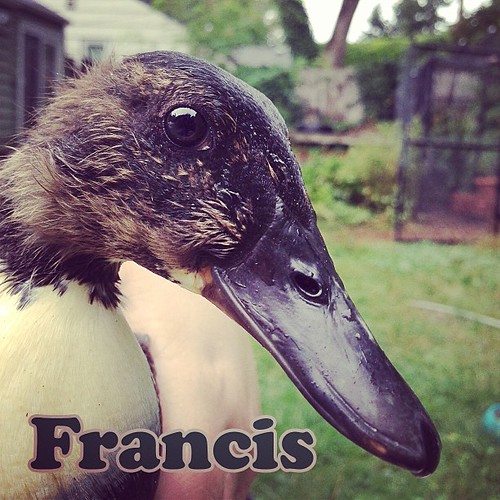
It is always difficult for me to take in a foster duckling. I don’t have room to keep a new, healthy duckling forever, and yet I get attached and want to make sure I find the safest, best forever home possible, which is never a guarantee that he’ll live a long and happy life. Francis was only with us a little more than a week, but he captured our hearts with his larger-than-life attitude and his bossy, feisty personality. We had big hopes and dreams for him, so it was hard to say goodbye so soon.
Rest in peace, little Francis. We wish we could have done more for you in your short time on Earth, but it wasn’t meant to be.
Lots of love, baby Francis.
XOXOX
P.S. Special thanks to everyone for the good thoughts and condolences on the loss of Francis. I know many of you got attached to him too, and it was a shock to see him go. Thank you for the support.
It’s Raccoon Time!
SPECIAL NOTE: This time of year, through the end of November, is often a very active time for raccoons in the Northwest. Take EXTRA care to keep your flocks safe and do not underestimate raccoons. They can attack any time of day or night, can reach through chicken wire, easily climb over fences and even turn locks and doorknobs. Double check that your flock is secure, and stay safe out there!
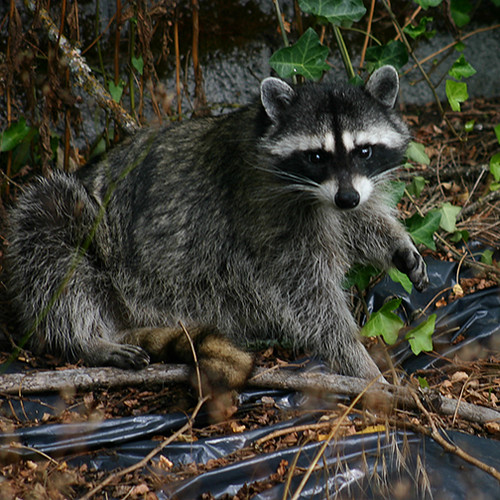
“What are you looking at?”
You, furface. Take a hike. You’re not welcome around here.

“Oh? I didn’t realize you were Queen of the Entire Planet, lady. Why don’t you go suck a latte.”
A smart mouth, eh? Well take your smart mouth and your ringed tail and hit the road, jack.
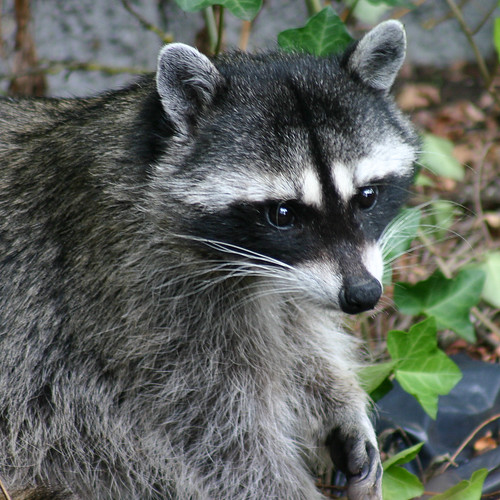
“I’ll think about it.”
Yeah you do that. How about you walk and think at the same time?

“Oh look! I think Mayor McGranola installed another bike lane. You’d better go check it out, hippie.”
I’m not falling for that, raccoon. Seriously, I’m losing my patience now. Get lost.

“You’re kind of a jerk, lady.”
I’m actually super unpredictable and could go bath-salt crazy on you at any moment. So don’t mess with me.

“That’s really messed up.”
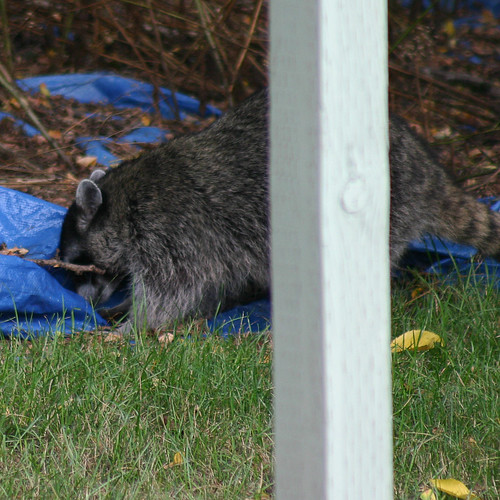
“I’m just going to chew through this tarp and eat some grubs underneath and then I’ll go. When I’m ready.”
I don’t think the neighbor would appreciate you chewing through their tarp, raccoon.
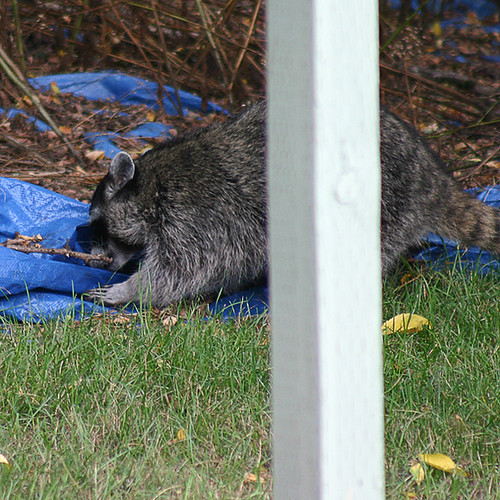
“Man, you really have some weird impression that I care what you think, lady. I’m almost done and I’ll leave when I’m ready to leave.”
________________
So that’s the raccoon story for today. The crows alerted me to the raccoon and Ruby did too. Thankfully I was home. The flock is pretty safe in the aviary because it’s covered and hot-wired where a raccoon might try to climb on top. But nothing is fool-proof. This was at 3pm today. A perfectly-healthy raccoon just out foraging for a meal. It’s important to know that they’re around day and night this time of year. So keep it in mind and keep your flock safe.
Quacks and clucks,
Tiff and the flock
Just Say No to Backyard Flocks

The backlash continues to grow against the urban farming trend when it comes to backyard flocks. In recent years, cities across the US have revised land use codes to permit backyard flocks. But now those same cities are seeing an increase in neighbor complaints, dumped and surrendered chickens and even rat infestations.
It’s a complex issue with emotional and political implications including social justice, personal freedom and self-sufficiency. But animal shelters and rescue groups will tell you it’s just gotten out of hand.
I have been rescuing and rehabilitating ducks and clucks for over nine years now. There hasn’t been a single day in that time when I am not at or beyond capacity. I don’t know of any reputable, safe sanctuary in the entire NW that isn’t also at capacity and constantly seeking safe homes for dumped poultry. Not one. It’s becoming a crisis and the animals are suffering.
One of the biggest problems we see when people decide to get backyard chickens is the information available is almost entirely skewed towards the positive aspects of urban flock keeping. Just look at this beautiful spread of chicken coops and accessories by Williams Sonoma:

http://www.williams-sonoma.com/shop/agrarian-garden/agrarian-garden-chicken-coops/
You know what’s missing from those professionally-photographed and beautifully-styled yuppy urban farms? A LOT. A WHOLE LOT.

Here’s our collage of the reality of many backyard flocks. This is just a few snapshots of what happens every day with backyard flocks. Not quite as romantic and beautiful as the Williams Sonoma catalog, is it?
This collage includes aggressive ducks or roosters that bite children, infected wounds from dumped geese attacked by dogs, chicken $#!t covered in flies, an injured rescued rooster covered in lice, a raccoon bite down to the vertebrae, raccoons, bloody wing from raccoon attack, hawks, $#!t-covered deck and porch, and rats… lots of rats.
So obviously we discourage backyard flocks. You don’t rescue over 100 birds in 9 years and come out thinking backyard flocks are an awesome idea. This isn’t to say that everyone is doing it wrong. But enough people are regretting their choice to get flocks that it’s causing a big problem for shelters and sanctuaries, and way too much unnecessary suffering for the animals caught in the middle.
So here’s our list of tips to seriously consider before ever taking on the commitment of a backyard flock. But honestly? Just don’t do it.
Tip #1: Protecting urban chickens is costly but required. Chicken wire is not predator proof. Hens are extremely vulnerable to predators like hawks, eagles, raccoons and dogs. Raccoons can reach right through chicken wire to eat hens through the wire, and often work in groups. Eagles and hawks don’t pick up hens and fly away with them, they just take a piece. Roomy coops with hardware cloth on all sides, top and bottom can provide safety for urban hens.
Tip #2: Roosters may be illegal where you live. When hatching chicks, what will you do with all the male chicks? There is no local or state agency to help with animal control issues for urban flocks. Resources at local shelters are very slim and most aren’t well-equipped to house poultry or other farm animals. Two roosters will fight and injure each other. Factory farms and hatcheries routinely grind up male baby chicks while they’re still alive. It is difficult to acquire hens without taking part in the cruelty that male chicks face. Ask before you buy, “What happens to the male chicks?”
Tip #3: Hens get sick. What will you do? When a hen is sick, do you know where to go for urgent treatment? It is important to ensure that even backyard hens are free from suffering and neglect. Basic veterinary care for infections, parasites or injuries can start at $80 and run into the hundreds of dollars. Birds are much better than dogs or cats at hiding illness, so it is critical to get them care quickly. Are you prepared to ensure your birds don’t suffer?
Tip #4: Chicken feed attracts rats and chicken droppings attract flies. Cleaning and maintaining urban coops on smaller lots can be difficult and time consuming. Flies and rats bring parasites and illnesses with them that can infect hens and other household pets. Rat populations can easily get out of control and often damage homes.
Tip #5: Hens don’t lay eggs every day. Many urban farmers get hens to ensure their families have humanely-raised, fresh eggs to eat. But hens have natural cycles that change as the seasons change, and sometimes they don’t lay eggs. Laying an egg every day takes a lot of nutrients, especially calcium. Poor nutrition or poor breeding can cause many hens to be prone to reproductive cancers and other maladies like prolapse and egg binding. First-time farmers often need to be reminded that hens are not egg-laying machines and each hen is an individual. Egg-laying hens reach their peak at 18-months but can live more than 10-years.
Tip #6: Hens crow too. While generally not as loud as roosters, hens crow too. Hens cluck in the morning quite early to be let out of their predator-proof nesting areas. In the summer when days are long, the hen crows can begin at 4:15am. Neighbors will tend to think you are illegally keeping roosters if they hear crowing, and may complain. Also, some hens cluck loudly when they lay eggs. It is important to keep in mind if you have close neighbors.
Tip #7: Each hen has a unique personality. While some breeds have specific characteristics, every hen is her own chicken. While they can be charismatic, emotional and interactive, some hens will attack and injure less dominant hens, especially if space or food is limited. Other hens will eat their own eggs. Some will chase other household pets or pluck out their own feathers. They are unique individuals and don’t always get along.
In summary, because hens are easy to hatch and cheap to buy, they are often treated as disposable animals. And hens that no longer lay eggs are considered useless. But when it comes to suffering, all animals are created equal. With proper care and attention, hens can live up to 10+ years. Before becoming responsible for the care and happiness of any living being, do all the research you can, and be wary of anyone who makes urban chicken coops seem simple and easy. It is a years-long commitment with daily, required care.
P.S. If you still still STILL think a backyard flock is for you, ADOPT! Please adopt. Do not buy or hatch while so many healthy, beautiful, loving, friendly birds languish in shelters.
Basic Duck or Chicken Exam
Because birds can be so good at hiding symptoms when they’re sick, it’s important to give them regular check-ups to ensure they’re happy and healthy. This is something you can do at home, and it will help you become familiar with what is normal and healthy for your duck or cluck, so you can start to tune in to subtle changes that might indicate a health problem before it gets too serious.
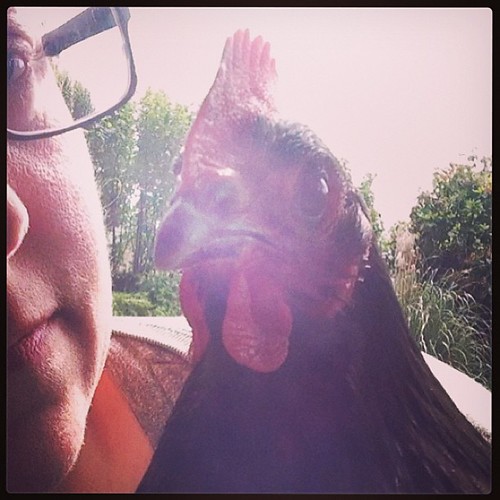
Start with the head and look at both eyes to ensure they are clear and bright. I find it helps if you say “look into my eyes,” but that’s optional. There shouldn’t be any discharge from the eyes, and no foam or debris near the eyes.
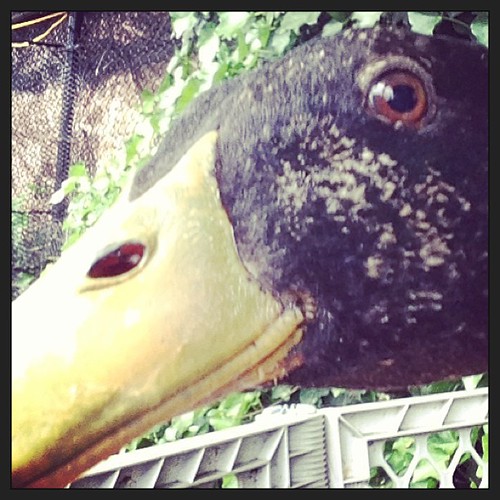
Then look at the nares or nostrils of the beak. They should be clear of debris and should not be runny or have other discharge.
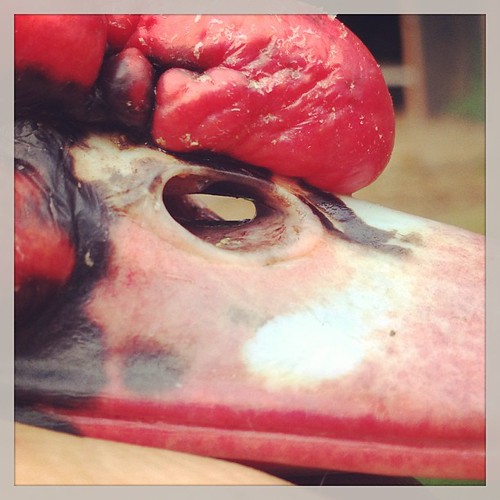
In ducks, you can often see clear through to the other side if the nares are clean.

Look at the feathers. They should be in good condition, with minimal breakage or wear. They should be shiny, bright and well kept.
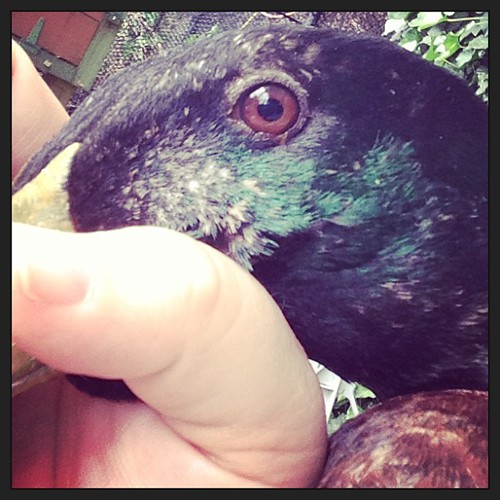
Fluff through the face feathers a bit, and see if you can get a look at the ear. It’s a little further back than I’m showing here, but my other hand was on the camera. This is one good way to see if your birds have feather mites. They’re different in ducks and chickens sometimes, so this is a good way to see them in ducks. I’ve found that you have to especially watch for feather mites in any handicapped birds who spend more time on the ground than usual.

Check the feet for any scuffs, abrasions or cuts. Those can sadly get serious pretty quickly, so it’s important to keep your flock on soft, safe material as much as you can.
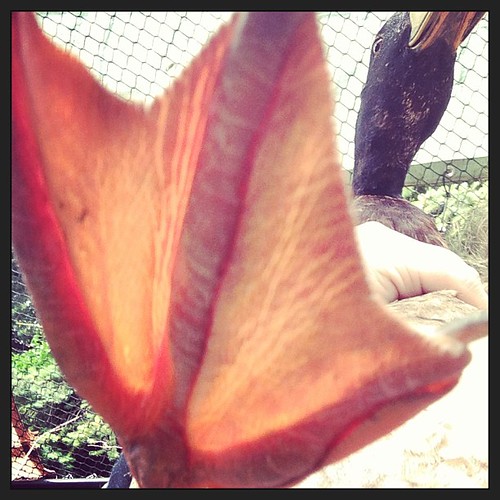
If you start to check feet weekly or every other week, you’ll start to get a good sense of what a healthy foot looks like, so you can be aware of any swelling or other changes.

I actually find the camera on a smart phone to be a good way to see feet when the flock doesn’t want to cooperate. With chickens, you’ll want to check all the scales on top of their feet and ankles. Scaly leg mites make these scales push out a bit and get dirt under them. If scales aren’t flat and tight against the foot, you may have scaly leg mites.
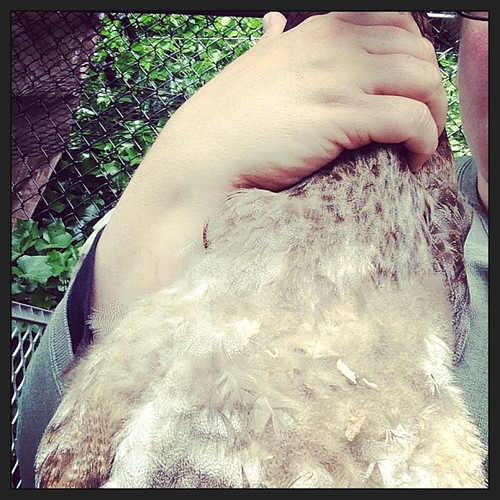
Take a look at the chest and belly of your duck or cluck. Feel along both sides of the keel – the hard cartilage that runs down the center of their chest. They should have some muscle on both sides of the keel. When they’re too thin, people say “this keel is sharp.” You’ll start to feel what’s normal if you keep checking. Here, Miles is missing a few belly feathers. That may mean he’s sleeping or napping somewhere that isn’t soft or clean. It’s something we’ll note and try to fix, then check again in two weeks.
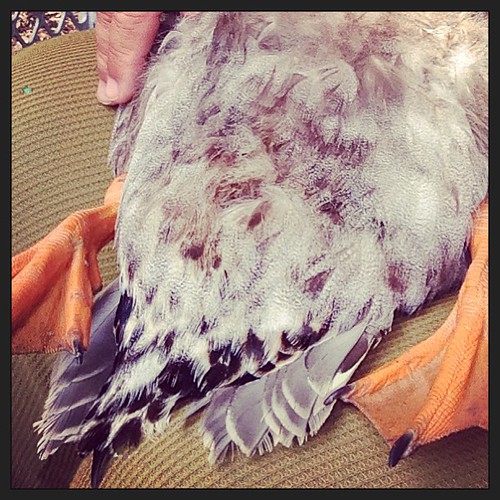
Then you’ll want to move to the dark side of the duck or cluck. Take a look at their vent area. It should be clean and dry.

Check out their poo. It can vary with ducks because they swim a lot, but with chickens it should be firm with clearly visible urates (white goo). This example shows a bright green color that you should always watch for – that bright light green is a bad sign. Unfortunately, some foods like corn can make a similar poo color. But if you have a flock, you now need to pay attention to poo.
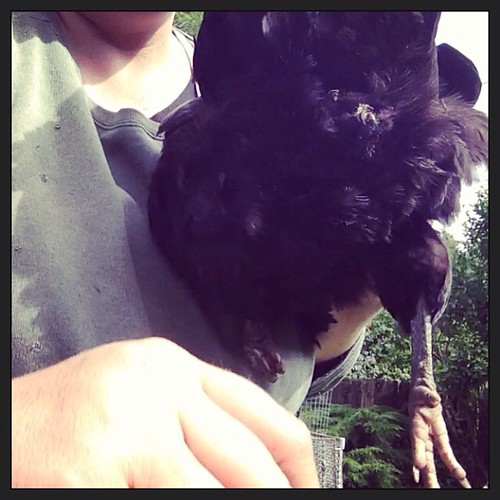
Chickens do tend to get a bit of poo stuck to their feathers now and then, but it shouldn’t be much. Too much can be a sign of problems.

With chickens, you’ll want to part the feathers near the vent and check for lice and mites.
Do this exam at least twice a month and you’ll start to learn the basic normal health status of each member of your flock. Then you are much more prepared to notice changes before they become serious problems. If you have an easy way to weigh your bird, that is also a great way to tell they’re eating consistently and feeling well. Once you’re done, pat the bird on the head and say “good birdie.” That’s it!
Here are a few links to further information on fun stuff like chicken parasites and illnesses.
Identifying chicken mites and lice: http://www.the-chicken-chick.com/2012/08/poultry-lice-and-mites-identification.html
Basic head exam for a parrot – helpful in showing how to find ears:
http://www.youtube.com/watch?v=y8e9xE5Tn2E
PDF chart of a basic bird exam for a cockatiel. Good details on what to watch for, including poo:
http://www.kaytee.com/assets/010/22969.pdf
Lastly, here are some of the supplies I keep on hand to check feet, treat tiny scrapes if they’re caught early, and to treat any feather mites, lice or scaly leg mites.
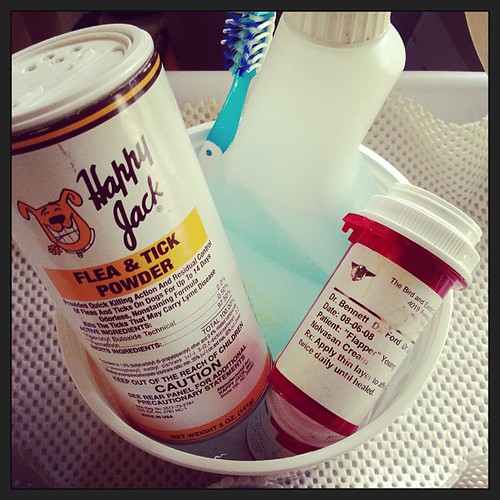
To check feet, sometimes I need to wash them. So I fill this tub with luke warm water and a drop or two of Dawn dishwashing detergent. Only Dawn. I use an old toothbrush to gently scrub off any dirt and then check the feet and ankles of the flock. The spray bottle has a very dilluted antibacterial spray called chlorhexidine. Always dillute it until it’s a very light blue. I also have nolvalsan antibacterial cream. Apparently it’s no longer available commercially but I get mine from our veterinarian. For any mites or lice, I use Happy Jack’s flea & tick powder. It’s what my vet uses too. You’ll want to wear gloves when applying it liberally to your bird. And it needs to be re-applied in 10-14 days to kill any eggs that hatch after the first application. You sprinkle it on the back, belly and under the wings and then rub it in. Birds will not like you after that, so you’d better bring treats.
That’s the basic duck and cluck exam we do here, much to the irritation of the flock. But it helps to keep them healthy and happy, and with regular exams, they also get easier to handle.
Quacks and clucks,
Tiff and the flock
What’s wrong with my duck?

At least once a week, we get asked to provide veterinary advice on an injured or sick duck. Let me use a people example to illustrate why we advise people to never ask for veterinary advice online. Here’s a post my friend made on Facebook about her ear infection…
“I need tried-and-true home remedies to relieve the pain from an ear infection. I tried the numbing drops, but they aren’t working.”
And here is a partial list of the remedies she received:
A drop of olive oil and a heating pad
DoTerra essential oils
Basil or Melaluca on a cotton ball and insert it in the ear
Lavendar oil and/or warm garlic oil
Heating pad and Tylenol
Advil and Mucinex
Antibiotics
Candling
A few drops of an onion
Real Sudafed (my suggestion to her)
Nasacort or Nasonex
Motrin
Warm wet wash cloth
Chew gum
Stick a slice of onion in your ear
Cotton with vapor rub
Silver biotics
Sweet oil
Whew! Now, how confident are you in all of those suggestions? What do we really know about her ear, how it got infected, what other medications she is taking, what other symptoms she may have or whether or not she’s already tried some remedies?
This is pretty similar to the quality of feedback you’ll get online if you ask what’s wrong with your pet duck (or chicken). If you have a duck and your duck gets sick or injured, and you don’t know too much about ducks, how well are you really describing your duck’s symptoms? The only responsible diagnosis is made from a qualified avian veterinarian using diagnostic tests like blood work and/or x-rays. This is an in-person exam and real test results. Anything other than that is a guess. And because it’s a guess, it could potentially do much more harm than good. People are very eager to offer help, too. But the potential for harm is just too great. So please be cautious and think twice about asking for advice online for your sick or injured pet.

That said, there are a few very common problems we see in young ducks and clucks. We wrote up a synopsis years ago about some of them, which you can find on the Duck Rescue Network website:
http://www.duckrescuenetwork.org/duck_care.html#illness
In addition to what’s posted there, I’ll also note that we see a ton of reproductive issues with young ducks and chickens. Egg-related problems are far too common in birds domesticated to lay too many eggs. Reproductive cancers can occur before the first year even, and peritonitis, yolk coelomitis and egg binding are extremely common. Another egg-related problem is prolapse. That’s where part of the inside of the duck or chicken is exposed through the vent. This can also happen to drakes who mate too much or injure their phallus. They end up with prolapse that will result in infection, necrotic tissue and death if not treated promptly.
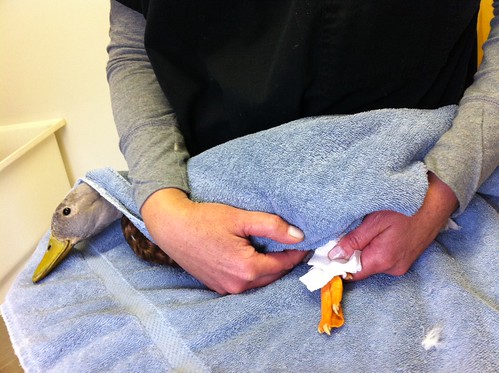
Ducks also get respiratory infections or other infections that often can be cleared up very easily with 10-days of the correct antibiotic. But it’s important to know what kind of infection you’re dealing with, so the treatment can be effective.
Lastly, birds are very good at hiding illness. Sometimes you’ll never know they’re sick until it’s too late. It’s part of what being a prey species is all about. You have to appear healthy at all times to remain safe. So by the time you notice symptoms, you may be dealing with a very serious situation. Here are some common symptoms of a sick or injured duck or chicken:
Keeping to themselves
Puffed up feathers
Less active
Off in a corner alone
Change in activity or routine
Eating less
Half-closed eyes
Excessive sleeping
Poop stuck to the vent
Diarrhea or differently-colored poop (unless they just drank a lot of water)
Ragged, poorly-preened feathers
Sneezing
Weight loss
Limping
Swollen joint
Open-mouth breathing
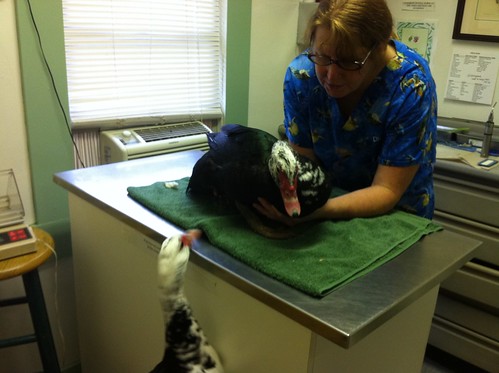
I wish we could provide simple, free answers for people with sick or injured ducks and chickens, but it just wouldn’t be the responsible thing to do. Hopefully the information here will be helpful for knowing what types of problems to look for, so you can catch them before they’re too serious. We’ll also post a “check-up” check list soon on how to monitor the health of your duck or cluck before they have a problem.
Oh! And if you need help finding an avian-certified veterinarian, try this website:
As always, quacks and clucks from the flock.
Want a Pet Duck?
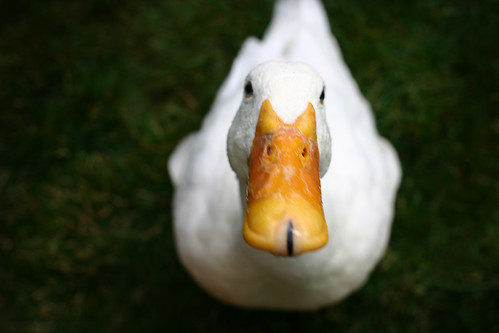
We wrote this list a few years ago, and since then, many people have had varying reactions to it. Some find it off-putting, but others have thanked us for the honesty and candor. So before you think of adding a flock to your family, please read on…
1. Ducks reach full size in about 5 weeks. They are cute and fluffy for 2 weeks and then they grow up. Ducks can live 10-20+ years, depending on the breed.
2. Ducks poop everywhere. You cannot train them.
3. You cannot raise a duck and “release it to the wild.” Mallards are wild ducks. Most other ducks were domesticated by humans. That means they no longer have wild instincts, can’t migrate and are usually too fat to fly. It is illegal to own wild ducks without a permit and illegal to release domestic ducks on public land. In some areas it is considered abandonment and can result in cruelty charges. It’s also a death sentence, as ducks raised by humans can’t fend for themselves in the wild. Did you know bread is bad for ducks? It lacks the basic nutrients they need to grow and thrive.
4. Qualified avian veterinarians to treat your special pet are few and far between. You can find a vet who treats parakeets, but not one who will treat your duck. If you do find one, expect to spend about $80-$120 for a basic duck check-up.
5. There is a reason for the saying “sitting duck.” Ducks need predator-proof pens with hardware cloth on all sides, top and bottom. They must be in these secure pens from dusk to sunrise in some areas, and at all times in other areas. Good pens that you build yourself start at around $300. Your home is not an exception because you haven’t seen a predator or you live on a pond. Raccoons reach through chicken-wire and climb over chain link with ease. Eagles and hawks don’t need to carry off your duck, they just grab a piece.
6. You won’t be able to take a vacation for the next 10-20+ years because there is no such thing as a duck sitter. You will realize this too late, when your vacation is already planned. Ducks require complicated care. Note: None of your friends or family wants to watch your duck while you are on vacation. They asked me to tell you that.
7. Ducks are more maintenance than the space shuttle. Bob Tarte wrote that line in his book, “Enslaved by Ducks.” Believe him. Don’t get a duck. Just read his book instead.
8. Ducks are extremely emotional. More emotional than cats or dogs. If you raise one duck and that duck depends on you, you cannot leave that duck alone for even one day without that duck missing you and getting upset/depressed/scared when you are gone. Don’t do that to a duck. Ducks need duck friends.
9. Ducks are time-consuming. They need twice-daily care, for at least 1/2 hour each time, every day of the year, rain or shine. They won’t thrive unless they get much more of your time than that. But that is the bare minimum amount of time required twice a day, every single day, without fail.
10. Ducks don’t believe you should have hobbies. Want to meet friends for dinner? Have to put your ducks away before dusk first. Want to have brunch on a Saturday? Need to clean the duck ponds first. Like to knit, sew, paint, listen to music, see movies, watch TV, play games, ride a bike? Forget it. Your sole hobby if you have a duck… is your duck. End of hobbies.
11. Do you live with your parents? Absolutely do not get a duck. You think you’ll keep the duck forever, but you will grow up and get interested in your friends or go to college. And you cannot keep a duck in your dorm room. Your parents absolutely do not want to care for your duck while you’re on a date or away at school. Your parents will tell you your duck died and give it away. Seriously. They told me to tell you that. Do not get a duck until you own your own home, can pay vet bills on your own, and can afford food and amenities for your duck.
12. Do you rent your home or live in an apartment? Every year thousands of people get ducks only to give them up because their landlord/girlfriend/boyfriend/parents/neighbors complained. Giving up a duck means that duck will probably be euthanized or suffer. Do not get a duck first and THEN research whether or not you’re allowed to have a duck. Some ducks are extremely loud. Too loud for neighbors. Way, way too loud. Trust me on this.
13. Have a dog? Think he’s old and friendly and wouldn’t hurt a fly? You’re wrong. Your duck will spaz out and flap in a way that will engage your dog’s innate prey instinct. Your dog will pick up your duck and shake it to death while you watch in horror. Yes. Your sweet little dog will do that. Your dog is not an exception. And it will be your fault, not your dog’s fault. Your dog is just being a dog. Do not get a duck if you have a dog. Your duck will taunt your dog. Your duck will chase and bite and taunt your dog until your dog bites it. That will also be your fault. Your duck is just being a duck.
14. Your duck is social and needs duck friends. Your duck does not want to live with just you. Your duck needs other ducks and more ducks means more poop. (See #2).
15. Every duck is a unique individual. Ducks are particular, and don’t automatically get along with other ducks. Two male ducks can kill each other. Too many male ducks can kill a female duck. Larger ducks will pick on smaller ducks and stronger ducks will try to kill weaker or injured ducks. Ducks act like dinosaurs much of the time. Cranky, cranky dinosaurs.
16. Ducks bite. Some male ducks bite all the time. They do not bite because they are mean. They bite because they love you. They bite hard. They bruise. They constantly bite your ankles, hands, arms, feet and face. You must wear long sleeves and long pants and socks and shoes to visit your ducks. 100 degrees outside? Make sure you’re wearing long pants and long sleeves to visit your ducks. Muscovy ducks have a ridge to their beak that can tear your skin off. Muscovy drakes often also protect their territory or decide you are a threat. Then they attack you. They fly at you and beat their 6-foot wing span wings at you, bruising and welting you. Their talons can be 1 1/2″ long and they will try to claw at you in mid-air. They bite and tear at you and chase you down, faster than you can run away.
17. Ducks make a huge mess when they eat. Duck food attracts rats and mice. In some areas, mice attract snakes. LOTS of snakes. Duck poop attracts flies. Having a pet duck means having rats and flies. It’s a package deal. Your neighbors will love that. Think you can kill the rats? Poison them and they will die in your duck pond, poisoning the pond your ducks drink from. Or their carcasses will attract predators. Try to trap and release them instead. Come winter time you can find them conveniently living in the roof of your house, or in your basement, for warmth.
18. Having a duck means hearing awful horror stories from everyone around you. People will think that because you have a duck, you must really want to hear their story about how a duck flew into their windshield. Or how their dog brought a duck in through the doggy door and splattered blood all over the walls! Or how their neighbor’s kid had a duckling but dropped it on its head and it had seizures and threw up before dying. Or how your neighbors had ducks but raccoons climbed into their pen and ate them. Or how their grandma had ducks and killed and plucked and slaughtered and cooked and served them for dinner. Or how a hawk flew down and ripped into a duck but no one ever took it to a veterinarian. Or how there’s this duck at the park that limps and drags itself along but that’s just nature! Gosh, aren’t those stories great? People can’t wait to share their duck stories! (All of these story examples are actual stories told to me by people who could not WAIT to share their wonderful duck anecdote!)
19. Horrible duck stories will give you nightmares. Only you’ll dream that your own duck is suffering or in danger or being eaten or maimed. You will have this nightmare a lot.
20. You will worry about your duck every day that you have it.
Lastly, if you’ve made it to the bottom of this list and you STILL think you’re the awesome saintly exception who is going to provide a super safe, loving home to a flock… please think of adopting or rescuing instead of hatching or buying. There are a ton of homeless ducks in need of great forever homes.
Thanks and quacks,
Ducks and Clucks
Current Cast of Characters
We have now been rescuing and rehabilitating ducks and other birds for over 9 years. In this time, we’ve had nearly 100 big personalities come and go, and our motley crew is constantly changing. Sometimes we worry that sharing our rescue work may inspire people to get ducks or chickens, which isn’t something we encourage for most folks. About half of all ducks and chickens hatched each year never live to see their first birthday, so adding a flock to your family is not something to take lightly.
All of our feathered and furry family members are rescued. Most are cast-offs of the urban farming craze, and others were injured or dumped. If anyone is considering adding a flock of chickens or ducks to their family, we strongly encourage adoption and animal rescue. So, so many ducks and clucks need safe, forever homes, and there are never enough good homes. Please don’t breed or buy animals.
Here’s a little update on our current cast of characters, including how they came to live at Ducks and Clucks.
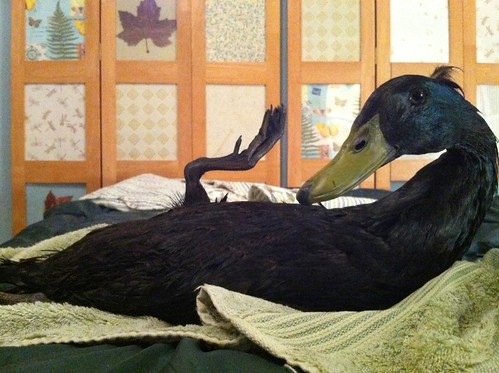
1. Lester Leroy is a crested cayuga or runner duck who came to us in January 2011. He is one of our most handicapped ducks. He was attacked by a dog and left untreated for nearly two weeks. Then he was surrendered to the Seattle Animal Shelter. He was recommended for euthanasia, because he couldn’t stand or walk or even sit normally. But we agreed to try and rehabilitate him. With physical therapy, he can now sit, stand and walk all on his own. It isn’t graceful, but he gets around just fine with some extra protection from the other more aggressive ducks. Lester is smitten with Danny girl and very protective of her.

2. Miles is a domestic rouen duck, very similar to a wild mallard but larger and unable to fly far. He was dumped in a park and developed a very serious leg infection. South Sound Critter Care in Kent, WA rescued him. But since he’s domestic, handicapped and can’t be returned to the wild, he came here to stay. Miles is also smitten with Danny girl, but a little too aggressive to live with her as a companion. So he loves her from the far side of the fence. He came to us in January 2012.
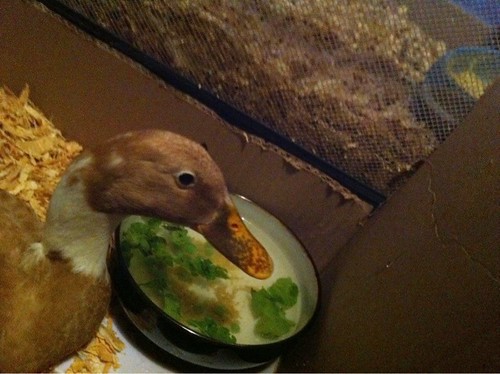
3. Danny girl is an Indian Runner duck. She was surrendered to PAWS in Lynnwood, WA in a very bad state. They only treat wild animals, so we were called to help. An x-ray determined that she had swallowed a very large slug of metal. Danny underwent antibiotics for an infection and months of chelation medication to safely dissolve the metal that was poisoning her. She was left with some permanent damage from the metal toxicity, but she gets around okay and is a very sweet girl. She loves both of her good buddies, Lester Leroy and Miles. She has been with us since December 2011.
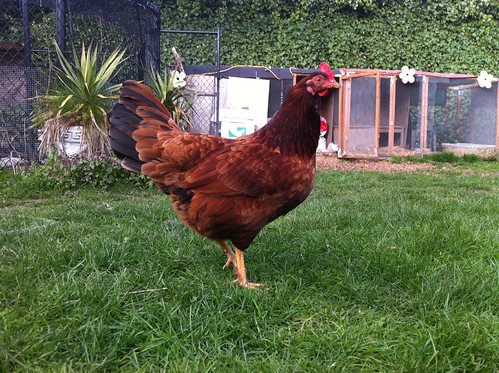
4. Carol hen came to stay with us in April 2011. We went to pick up a fluffy rooster who needed medical care from the Seattle Animal Shelter, and Carol was there as well, so we brought her home. Fabio the rooster went to another sanctuary when he was better, but Carol was here to stay. She wasn’t injured, just homeless. She had been found wandering a neighborhood in North Seattle and was picked up by animal control. She is a fierce, cranky hen who has grown into a lovable but noisy sweetheart.
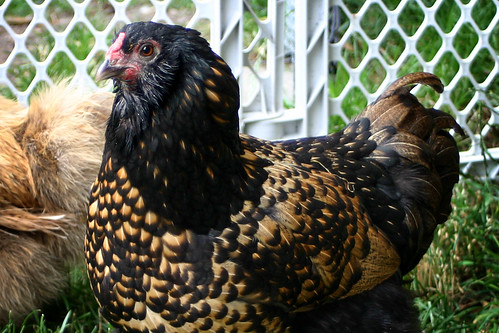
5. Olivia is a sweet old hen who came in with another hen and a handicapped duck in July 2009. Both she and her friend Racquel L’Oreal, who has since passed from old age, came in with parasites and respiratory infections from living in unsanitary conditions. Their duck friend was euthanized after her handicaps became too severe and her quality of life declined. Olivia is estimated to be over 12-years-old now, which is a good reminder to anyone thinking of getting chickens. They can sometimes live for well over a decade with good care and nutrition.
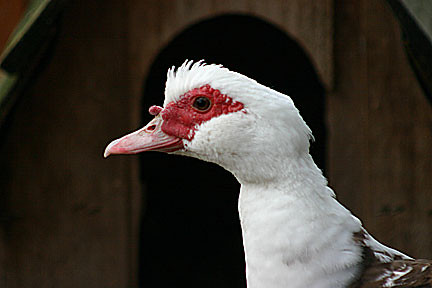
6. Petunia Peach is a muscovy duck we adopted from another sanctuary in January 2006 to help even out our flock when we ended up with too many drakes. She is probably almost 9-years-old now and still doing well. She came to us with a sister named Phoebe Kay, who passed on from yolk coelomitis, which is unfortunately a common reproductive problem with ducks and chickens bred to lay many eggs. Petunia has been O’Malley’s companion for many years.
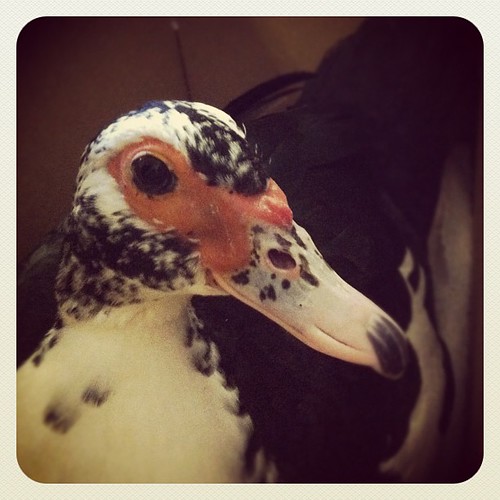
7. Lenora Bea is a muscovy duck who came to us in November 2012 from the Seattle Animal Shelter. She was found wandering in a South Seattle neighborhood. Many ducks and chickens are surrendered to the Seattle Animal Shelter, and we don’t always have room to help. But this time it was the right time and the right kind of duck to fit right into our flock. She is O’Malley’s new companion, and she helps keep him on his toes.
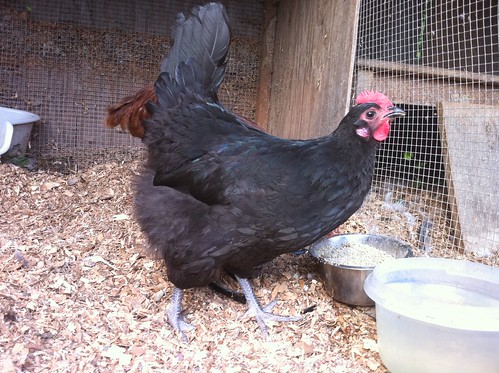
8. Olly Astro hen came to us in August 2010 after being surrendered to a veterinarian. She had severe pneumonia that required 8-weeks of antibiotics to treat. She is still prone to respiratory infections, but has done well here. She also has recurring egg issues and was spayed to help cure her chronic reproductive infections. She came in along with her friend Janet who has since passed on.
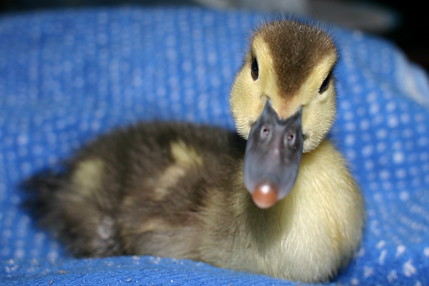
9. O’Malley Peepers is a muscovy drake duck who arrived in September 2005 as a baby duckling. He was found abandoned and alone in a park in Gig Harbor, WA and taken to PAWS in Lynnwood, WA for rehabilitation. Within a day, they realized he was growing faster than his mallard cohorts and too friendly to be a wild duck. So we agreed to take him in. He is our big boy, and the flock member who has been with us the longest right now. He loves his two ladies Petunia Peach and Lenora Bea, but he also loves his people.
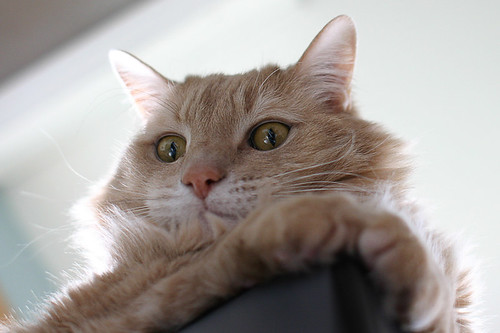
10. Simon is our only furry family member right now. He was adopted from the ASPCA in NYC years and years ago, and he’s about 17-years-old now. He has lived with us in New York City, San Francisco and now Seattle. So he’s a well-traveled rescue kitty.
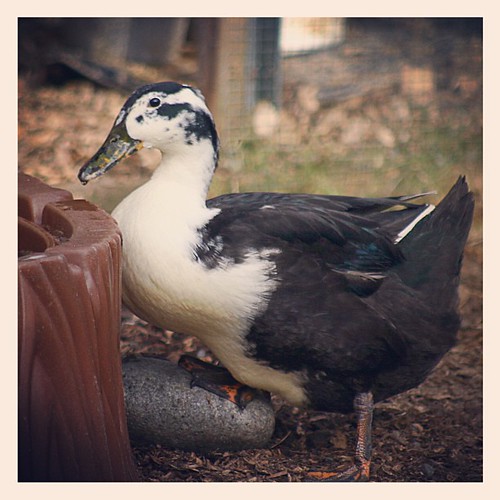
11. Ruby Tuesday is our newest rescue, a magpie duck found abandoned by the side of the road in Southern Washington in December 2012. A good samaritan drove her 3 hours to us, because they wanted to find a safe home for her. She is likely young, and she’s healthy and happy. She had a brief love affair with Miles but has since settled down with her steady beau, Lionel.
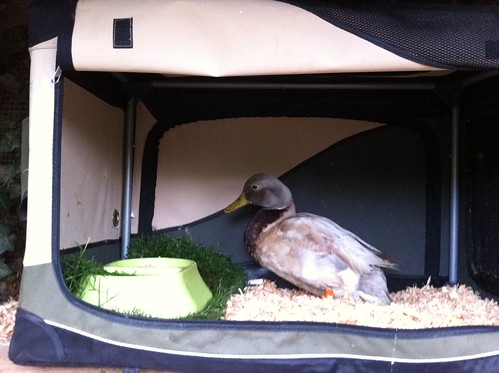
12. Lionel Ernest is a bantam saxony duck or hybrid pastel call duck who was dumped at Country Village stores in Bothell, WA in May 2012. He was taken in by PAWS in Lynnwood, WA and transfered to us for medical treatment. He had a severely infected and painful foot when he arrived, and he was really worried and scared. But now he’s doing well. He loves his lady duck Ruby and follows her everywhere, pointing out treats for her and protecting her from imaginary dangers.
ALSO! Here’s the story for newcomer Si, not pictured above.

Si came to us as a foster chicken in late November 2013. She had been dumped in a forest, rescued, and then attacked by a raccoon that unfortunately killed her friend. She was banded and wasn’t a first-year hen, so it’s possible she was dumped because she had stopped laying eggs or slowed down her egg production. She had a few minor bite wounds from her raccoon attack and an infected eye, but she recovered very quickly. Unfortunately her rescuers decided not to take her back, so she became a permanent resident here at Ducks and Clucks.
Whew! That’s a little background info on each of our current cast of characters. Sometimes needs change, and we work with other local rescue folks to try and bridge the gap for these birds in need. As we mentioned, for anyone considering ducks or clucks, we encourage you to do thorough research and find sources that DON’T sell animals to get the full story on their care and maintenance. We also encourage people to rescue and adopt, and never buy or breed more animals while so many await safe, forever homes.
Quacks and clucks,
Tiff and the flock

